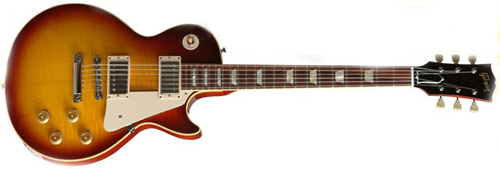The Gibson Les Paul is a solid body electric guitar originally developed in the early 1950s. The Les Paul was designed by Ted McCarty in collaboration with popular guitarist Les Paul, whom Gibson enlisted to endorse the new model.

| Gibson Les Paul 59 Reissue Guitar |
Gibson Les Paul 59 Reissue Guitar |
|
Home > All Guitars
> Gibson Models >
Gibson Home
The Gibson Les Paul is a solid body electric guitar originally developed in the early 1950s. The Les Paul was designed by Ted McCarty in collaboration with popular guitarist Les Paul, whom Gibson enlisted to endorse the new model.
The Les Paul model was the result of a design collaboration between Gibson Guitar Corporation and the late pop star, electronics inventor, and accomplished jazz guitarist Les Paul. In 1950, with the introduction of the Fender Telecaster to the musical market, electric guitars became a public craze. In reaction, Gibson Guitar president Ted McCarty brought guitarist Les Paul into the company as a consultant. Les Paul was a respected innovator who had been experimenting with guitar design for years to benefit his own music. In fact, he had hand-built a solid-body prototype called "The Log", a design widely considered the first solid-body Spanish guitar ever built, as opposed to the "Hawaiian", or lap-steel guitar. This guitar is known as "The Log" because the solid core is a pine block whose width and depth are a little more than the width of the fretboard. Although numerous other prototypes and limited-production solid-body models by other makers have since surfaced, it is known that in 1945–1946, Les Paul had approached Gibson with "The Log" prototype, but his solid body design was rejected. In 1951,this initial rejection became a design collaboration between the Gibson Guitar Corporation and Les Paul. It was agreed that the new Les Paul guitar was to be an expensive, well-made instrument in Gibson's tradition. Although recollections differ regarding who contributed what to the Les Paul design, it was far from a market replica of the Fender models. Since the 1930s, Gibson had offered electric hollow-body guitars, such as the ES-150; at minimum, these hollow-body electric models provided a set of basic design cues to the new Gibson solid-body, including a more traditionally curved body shape than offered by competitor Fender, and a glued-in ("set") neck, in contrast to Fender's bolt-on neck joint design.
The significance of Les Paul's contributions to his Gibson guitar design remains controversial. The book "50 Years of the Gibson Les Paul" limits Paul's contributions to two: advice on the trapeze tailpiece, and a preference for color (stating that Paul preferred gold as "it looks expensive", and a second choice of black because "it makes your fingers appear to move faster on the box", and "looks classy—like a tuxedo"). Additionally, Gibson's president Ted McCarty states that the Gibson Guitar Corporation merely approached Les Paul for the right to imprint the musician's name on the headstock to increase model sales, and that in 1951, Gibson showed Paul a nearly finished instrument. McCarty also claims that design discussions with Les Paul were limited to the tailpiece and the fitting of a maple cap over the mahogany body for increased density and sustain, which Les Paul had requested reversed. However, according to Gibson Guitar, this reversal would have caused the guitar to become too heavy, and Paul's request was refused. Another switch: the original Goldtop was to be all mahogany and the later Custom was to have the maple cap/mahogany body. Beyond these requests, Les Paul's contributions to the guitar line bearing his name were stated to be cosmetic. For example, ever the showman, Paul had specified that the guitar be offered in a gold finish, not only for flashiness, but to emphasize the high quality of the Les Paul instrument, as well. The later-issue Les Paul models included flame maple (tiger stripe) and "quilted" maple finishes, and once again contrasted the competing Fender line's range of car-like color finishes. Gibson was notably inconsistent with its wood choices, and some goldtops or customs have had their finish stripped to reveal beautifully-figured wood hidden underneath. Now, we were going to talk about the Gibson 59 Reissue. This guitar has a fatter, rounded neck (mahogany, of course) mahogany body and a figured (flame maple) top. This was topped off with vintage looking (yellowed) plastic inlays. The big difference (in terms of playability and sound) was the rounded, fatter sounding 1959 style neck. (As opposed to the later, 1960's thinner neck.) This rounded neck and flame maple top guitar with yellow plastic inlays sells for around $6,000.00. Overpriced? You judge. (That includes a Gibson hardshell case.)
|